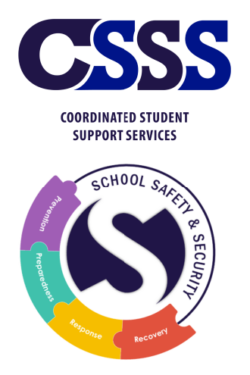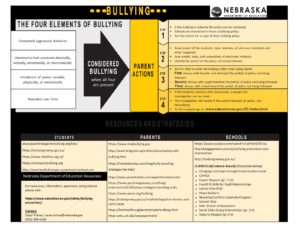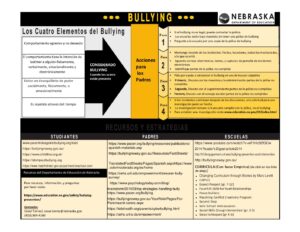Bullying Resources for Parents
Guidance for Parents Responding to Bullying Behavior
We recommend that parents take a collaborative approach when communicating with schools and collecting evidence of incidents of bullying. Further, it is important to continue to communicate with your student and work collaboratively with your school.
The chart below contains steps that parents can follow when your student is involved in bullying.
Guidance for Caregivers Responding to Bullying Behaviors
Many caregivers experience their child coming home distressed due to conflict or bullying at school. Knowing how to navigate this situation as a caregiver outside of the school system can be difficult. We want you to know that you have the right to be involved in your child’s experiences at school. The chart above outlines the steps that caregivers can follow when your student is involved in bullying. We recommend that caregivers take a collaborative approach when addressing their student’s bullying involvement. This includes communicating with schools and working together to keep your child safe. We also recommend documenting all communication with the school regarding the bullying behaviors or disciplinary actions to assist in gathering evidence of the bullying incidents. As the above chart outlines, we recommend first meeting with the school principal to communicate your concerns for your child’s safety. It is helpful to find the school’s bullying and harassment policy as this outlines their agreed-upon plans for responding to and disciplining bullying incidents. A school’s bullying policy will be in their handbook, district website, or by asking the principal when you meet with them. This will serve as a reminder of the policy the school has agreed to follow and helps guide the conversation about how to support your child best moving forward.
Caregiver Information
Parents can become involved in reducing violent behaviors and creating safer environments for their children at home and school. Parents are encouraged to review school handbooks, websites, or other district sources of information relating to bullying and discuss the policy and expectations with their children.
Parent–School Collaboration
A partnership between parents and the school to prevent bullying behaviors is based on a shared understanding of bullying, the policies of the school, and essential intervention strategies.
- When the school and parents initiate conversations with children about bullying in general terms, children know they can also discuss this issue. Continue to have conversations with your students and encourage them to talk about any bullying they may be experiencing.
- Bullying issues at school can generally be addressed when parents talk with the classroom teacher, school counselor, or building administrator.
- Parents and school staff should be familiar with the school’s anti-bullying policy and any related policies or programs and address bullying behaviors using the appropriate process. When making a report, providing a clear and detailed description of what has been observed or experienced is helpful. All reports should be taken seriously and acted on using established policies and procedures.
- Bullying behavior occurs across multiple platforms. Parents should be aware of the different activities their students are involved in. This includes a student’s presence on online platforms, which include social media, gaming, and other forms of communication.
- Often, kids who are victims of cyberbullying may not realize their experiences online are harassment or bullying. Students may worry that their phones or communication devices will be taken away. Cyberbullying has adverse effects on everyone involved. Parents need to be aware of their student’s social media use and use instances of hostile online behavior as educational moments.
Reporting Procedures
Refer to the school district’s anti-bullying policy and reporting procedures for guidance on the local report-making process. If that is not available, typically, the following procedure is appropriate. Generally, reporting bullying behaviors to the school begins with the classroom teacher or building administrator and proceeds to the following contact only if the issue is unresolved.
- Report to the classroom teacher, school counselor, or principal
- Report to the district superintendent
- Report to the district school board
- Contact the Nebraska Department of Education School Safety for additional complaints and assistance walking through the above steps (402-471-0986)
If the bullying behavior involves criminal conduct (theft, assault, battery, etc.), use the following reporting procedure in addition to notifying the school.
- Report to local law enforcement
- Contact the county attorney.
Reporting – CyberBullying Research Center
The Cyberbullying Research Center is a website that provides information and resources on cyberbullying and other online issues affecting adolescents. Cyberbullying is the intentional and repeated use of electronic devices to harm others. The website is based on over fifteen years of research by Dr. Sameer Hinduja and Dr. Justin W. Patchin, experts in cyberbullying. The website aims to help parents, educators, professionals, and youth understand and prevent cyberbullying.
Report Cyberbullying | Social Media Apps, Gaming, and Online Platforms









